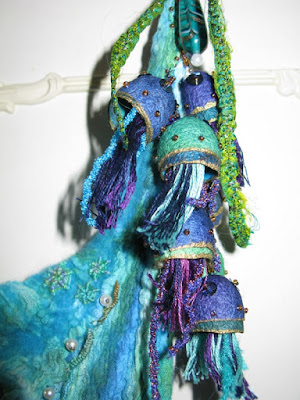Photomask
From Wikipedia, the free encyclopedia

A schematic illustration of a photomask (top) and an integrated circuit created using that mask (bottom).
A
photomask is an opaque plate with holes or transparencies that allow light to shine through in a defined pattern. They are commonly used in
photolithography.
Overview

An actual photomask. The thicker features are the integrated circuit which is desired to be printed on the wafer. The thinner features are assists which do not print themselves but help the integrated circuit print better out-of-focus. The zig-zag appearance of the photomask is because
optical proximity correction was applied to it to make it print better.
Lithographic photomasks are typically transparent
fused silica blanks covered with a pattern defined with a chrome metal absorbing film. Photomasks are used at wavelengths of 365
nm, 248 nm, and 193 nm. Photomasks have also been developed for other forms of radiation such as 157 nm, 13.5 nm (
EUV),
X-ray and
electrons and
ions, but these require entirely new materials for the substrate and the pattern film.
A set of photomasks, each defining a pattern layer in
integrated circuit fabrication, is fed into a photolithography
stepper or
scanner and individually selected for exposure. In
double patterning techniques, a photomask would correspond to a subset of the layer pattern.
In photolithography for the
mass production of
integrated circuit devices, the more correct term is usually
photoreticle or simply
reticle. In the case of a photomask, there is a one-to-one correspondence between the mask pattern and the wafer pattern. This was the standard for the 1:1 mask aligners that were succeeded by steppers and scanners with reduction optics. As used in steppers and scanners, the reticle commonly contains only one layer of the chip. (However, some photolithography fabs utilize reticles with more than one layer patterned onto the same mask). The pattern is projected and shrunk by four or five times onto the wafer surface. To achieve complete wafer coverage, the wafer is repeatedly 'stepped' from position to position under the optical column until full exposure is achieved.
Features 150 nm or below in size generally require
phase-shifting to enhance the image quality to acceptable values. This can be achieved in many ways, but the two most common methods are to use an attenuated phase-shifting background film on the mask to increase the contrast of small intensity peaks, or to etch the exposed
quartz so that the edge between the etched and unetched areas can be used to image nearly zero intensity. In the second case, unwanted edges would need to be trimmed out with another exposure. The former method is
attenuated phase-shifting, and is often considered a weak enhancement, requiring special illumination for the most enhancement, while the latter method is known as
alternating-aperture phase-shifting, and is the most popular strong enhancement technique.
As leading-edge semiconductor features shrink, photomask features which are 4× larger must inevitably shrink as well. This could pose challenges as the absorber film will need to become thinner, and hence less opaque.
[1] A recent study by
IMEC has found that thinner absorbers degrade image contrast and hence contribute to line-edge roughness, using state-of-the-art photolithography tools.
[2] One possibility is to eliminate absorbers altogether and use 'chromeless' masks, relying solely on phase-shifting for imaging.
The emergence of
immersion lithography has a strong impact on photomask requirements. The commonly used attenuated phase-shifting mask is more sensitive to the higher incidence angles applied in "hyper-NA" lithography, due to the longer optical path through the patterned film.
[3] Mask Error Enhancement Factor
Leading edge photomasks contain (pre-corrected) images of the final chip patterns magnified by 4x. This magnification factor has been a key benefit in reducing pattern sensitivity to imaging errors. However, as features continue to shrink, two trends come into play: 1) the mask error factor begins to exceed 1, i.e., the dimension error on the wafer may be more than 1/4 the dimension error on the mask,
[4] and 2) the mask feature is becoming smaller, and the dimension tolerance is approaching a few nanometers. As an example, a 25 nm wafer pattern should correspond to a 100 nm mask pattern, but the wafer tolerance could be 1.25 nm (5% spec) which translates into 5 nm on the photomask. The variation of electron beam scattering in directly writing the photomask pattern can easily well exceed this.
[
Fashion Design Fox Single Shoulder Bag Orange
Fashion Flower Printed Dual Purpose Bag
Strips Dual Purpose Bag Black&White
Fashion Design Fox Single Shoulder Bag Watermelon Red
Western Street Style Contrast Color Cool Bag Khaki


























